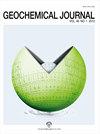用于元素分析仪-同位素比质谱仪的金包银胶囊:对岩石材料预处理有机碳和δ13C分析具有强大的抗氧化能力
IF 1.6
4区 地球科学
Q3 GEOCHEMISTRY & GEOPHYSICS
引用次数: 1
摘要
Fujisaki et al., 2016, 2018, 2019)。为了准备样品进行EA-IRMS OC分析,需要去除共存的碳酸盐矿物,以确保准确和精确的定量。例如,对于含有1 wt% OC和1 wt%碳酸盐衍生C的沉积物样品,总C为2 wt%,而非酸化(非脱钙化)样品的δCtotal C约为-11‰,因为典型的远洋沉积物的δ cgc约为-22‰,而底栖有孔虫的δ c酸盐约为0‰。在这种情况下,δCtotal C值不能作为δCorg的代表。已经提出了几种去除碳酸盐矿物的方法,例如使用盐酸、磷酸或硫酸进行酸处理(al - aasm等人,1990年;Brodie et al., 2011)和逐步燃烧法(Uchida et al., 2008)。酸处理可用于元素分析仪-同位素比质谱仪的金包银胶囊:对岩石材料的预处理具有很强的抗氧化性,可用于有机碳和δ13C分析本文章由计算机程序翻译,如有差异,请以英文原文为准。
Gold-coated silver capsule for elemental analyzer-isotope ratio mass spectrometer: Robust against pretreatment of rock material for organic carbon and δ13C analyses
Fujisaki et al., 2016, 2018, 2019). To prepare the samples for OC analysis with EA-IRMS, coexisting carbonate minerals need to be removed to ensure accurate and precise quantification. For example, for a sediment sample that contains 1 wt% OC and 1 wt% carbonate derived C, the total C would be 2 wt% and the δCtotal C of the non-acidified (non-decalcified) sample would be about –11‰, since the δCorg of a typical pelagic sediment is about –22‰ while the δCcarbonate of benthic foraminifera is about 0‰. In this case, the δCtotal C value cannot be used as a proxy for the δCorg. Several approaches have been proposed for removing carbonate minerals, such as acid treatment using either hydrochloric, phosphoric, or sulfurous acid (Al-Aasm et al., 1990; Brodie et al., 2011) and the stepwise combustion method (Uchida et al., 2008). Acid treatment can be Gold-coated silver capsule for elemental analyzer-isotope ratio mass spectrometer: Robust against pretreatment of rock material for organic carbon and δ13C analyses
求助全文
通过发布文献求助,成功后即可免费获取论文全文。
去求助
来源期刊

Geochemical Journal
地学-地球化学与地球物理
CiteScore
1.70
自引率
12.50%
发文量
11
审稿时长
6 months
期刊介绍:
Geochemical Journal is an international journal devoted to original research papers in geochemistry and cosmochemistry. It is the primary journal of the Geochemical Society of Japan. Areas of research are as follows:
Cosmochemistry; Mineral and Rock Chemistry; Volcanology and Hydrothermal Chemistry; Isotope Geochemistry and Geochronology; Atmospheric Chemistry; Hydro- and Marine Chemistry; Organic Geochemistry; Environmental Chemistry.
 求助内容:
求助内容: 应助结果提醒方式:
应助结果提醒方式:


